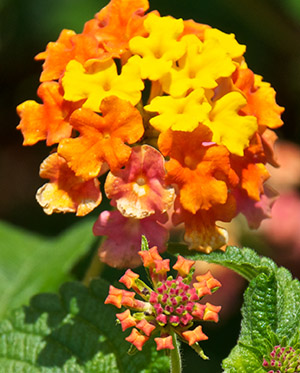Lantana (Lantana camara) is in the Verbena family (Verbeneaceae), and it is native to tropical America from Mexico to Colombia. It is a familiar garden shrub here in the Southeast, and it has many good features, including showy flowers, a long flowering season, and its attractiveness to butterflies, moths, bees, and hummingbirds. There are several color varieties, and in some of these the flowers change color as they mature. Lantana does not seem to be susceptible to insects or plant diseases, and it is not eaten by deer. In addition, it is very tolerant of heat and dry conditions.
Lantana sounds like a perfect plant for the garden. However, there are some problems with it. The leaves produce a very nasty smell when they are crushed, and the foliage and unripe berries are very toxic. In many countries it has become an invasive weed that out-competes the native flora. We have seen large stands of it in East Africa and in India. Its seeds are scattered widely by birds, and it is difficult to eradicate, because it readily grows back if it is cut down.
In our area, most Lantana varieties do not survive the winter. However, the variety “Miss Huff” is very cold tolerant and can be grown as a perennial. It was first introduced by Goodness Grows Nursery in Lexington, Georgia, when they noticed a Lantana in the yard of Miss Ruby Huff that appeared to regrow from the roots every year. Other good features of Miss Huff include the attractive way that the flowers change from yellow to orange to pink as they age. Since it produces few seeds, it is not likely to become a pest in the garden.


Pingback: Skipper on Lantana | A Naturalist's Journal